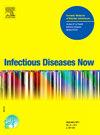计算机断层扫描诊断hiv相关的胃肠道组织浆菌病。
IF 2.2
4区 医学
Q2 INFECTIOUS DISEASES
引用次数: 0
摘要
简介:播散性组织胞浆菌病是拉丁美洲人类免疫缺陷病毒(PLHIV)感染者中主要的机会性感染之一。肠道受累是常见的,但其计算机断层扫描结果尚未得到适当的描述。我们的目的是提供组织胞浆菌病累及肠道的计算机断层扫描描述。患者和方法:我们对已证实累及肠道的弥散性组织胞浆菌病患者进行了回顾性观察研究。结果:共纳入18例可用的增强腹部计算机断层扫描患者(8名女性,平均年龄44 岁)。17例肠壁增厚(94 %),平均增厚14 mm,单灶或多灶,常呈圆周状(71 %)。盲肠和右结肠最常见,各占13/17(76 %)。腺肿大不变,多数均质。结论:在没有证实组织浆菌病的情况下,这些晚期HIV患者的计算机断层扫描特征可能是早期诊断的关键发现。本文章由计算机程序翻译,如有差异,请以英文原文为准。
Computed tomography for the diagnosis of HIV-associated gastro-intestinal histoplasmosis
Introduction
Disseminated histoplasmosis is one of the leading opportunistic infections among people living with human immunodeficiency virus (PLHIV) in Latin America. Intestinal involvement is common, but its computed tomography findings have not been properly described. We aimed to provide a computed tomography description of histoplasmosis intestinal involvement.
Patients and methods
We performed a retrospective observational study of patients with disseminated histoplasmosis and proven intestinal involvement.
Results
A total of 18 patients with an available contrast-enhanced abdominal computed tomography (8 women, mean age 44 years) were included. Seventeen had intestinal parietal thickening (94 %), with a mean thickening of 14 mm, unifocal or multifocal, frequently circumferential (71 %). The most commonly affected segments were the cecum and right colon in 13/17 (76 %) of patients each. Adenomegaly was constant, mostly homogeneous.
Conclusion
These computed tomography features in patients with advanced HIV disease may be key findings for an early diagnosis in the absence of proven histoplasmosis.
求助全文
通过发布文献求助,成功后即可免费获取论文全文。
去求助
来源期刊

Infectious diseases now
Medicine-Infectious Diseases
CiteScore
7.10
自引率
2.90%
发文量
116
审稿时长
40 days
 求助内容:
求助内容: 应助结果提醒方式:
应助结果提醒方式:


